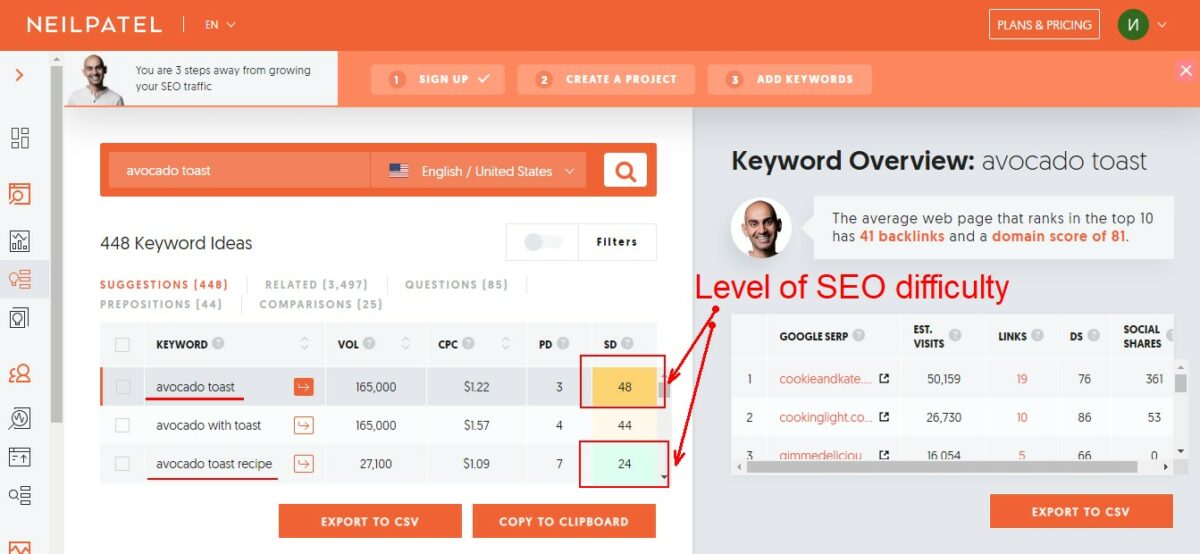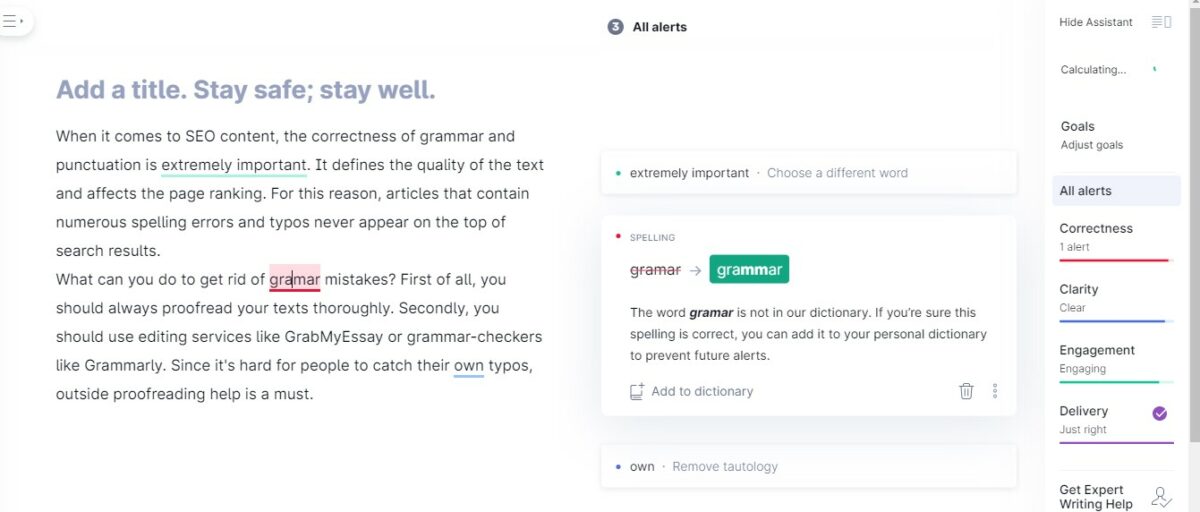Do you want to get your content visible on Google? Write SEO content to hit your goal! Improve readability, check grammar, add the right keywords. Your web page will automatically get to the top of the search results.
Are you looking for handy tips on how to create SEO content? We’ve got you covered. Here is a short how-to guide for you.
Research keywords
First thing first, if you want to create SEO content, you need to know what keywords to use.
You should research keywords using tools like Google Keyword Planner, Ubersuggest, or Ahrefs and choose high-traffic low-competition words.
Let’s consider a simple example. Imagine you are going to write a blog post about “avocado toast”. You check this keyword using Ubersuggest and see that it has a high level of SEO difficulty. Also, you see that another relevant keyword, “avocado toast recipe,” has a much lower level of SEO difficulty.
If you use “avocado toast recipe” as a focus keyword, you will significantly boost your SEO writing efforts. You will double your chances to get your blog post to appear at the top of Google search results.
Use headlines and subheadings
SEO-friendly content is a well-structured content. Therefore, you should use a headline and subheadings to break down your article.
A general rule of thumb is to never put more 300 words to below an HTML heading or subheading. Preferably, you should add a new subheading every 60-200 words.
Why headings and subheadings are that important? They allow both users and Google crawlers to skim through the text quickly.
Headings and subheadings help to convince everyone who visits your page that the content is relevant to the search query and that it is worth reading.
Add bulleted lists
A bulleted list is another tool that you can use to make your texts skimmable. Whether you want to specify features of your products or list benefits, feel free to add bullet points.
Just keep the following tips in mind:
- Don’t create too long lists – Every list should include up to ten bullet points. If you need to add more points, use sub-bullets.
- Keep the bullets symmetric – Keep the length of the bullet points on your list roughly the same.
- Use continuous grammar – Write all of your bullets using correct grammar and punctuation, based on the sentence that goes before the list.
Avoid complexity
When writing SEO content, you should strive for simplicity:
- Don’t use rarely-used, sophisticated words – choose simpler alternatives. For instance, replace the word “alleviate” with the word “ease”, and “disburse” with “pay off” where it’s possible.
- Get rid of sentences in the passive voice. Stick to the active voice. That will add flow to your writing.
- Avoid using jargon and technical term. Use commonly used words instead.
- Don’t overuse adverbs. That may lower the readability level.
Focus on quality
Searching engines are extremely smart. So don’t try to trick them. Don’t overuse keywords and don’t use any other “unfair SEO tactics”. It will not help you to achieve the desired results.
If you want Google to notice your website, you should create high-quality content that adds real value to your readers. Your articles must be informative, interesting to read, and relevant.
Do you need professional writing help? Use writing services like TrustMyPaper and BestEssaysEducation or get assistance from freelance SEO experts at Upwork or Fiverr. Let the qualified writers guide you in the right direction so that you can achieve your goals sooner.
Check grammar
When it comes to SEO content, the correctness of grammar and punctuation is extremely important. It defines the quality of the text and affects the page ranking. For this reason, articles that contain numerous spelling errors and typos never appear on the top of search results.
What can you do to get rid of grammar mistakes? First of all, you should always proofread your texts thoroughly. Secondly, you should use editing services like TopEssayWriting or grammar-checkers like Grammarly. Since it’s hard for people to catch their own typos, outside proofreading help is a must.
Optimize the length
Modern users are looking for meaningful, insightful content. And Google knows that. For this very reason, longer, information-dense articles are ranked higher than short blog posts.
According to HubSpot’s recent study, the perfect length of the post is the following:
- “What is” posts – between 1,300 and 1,700 words
- “How-to” blog posts – between 1,700 and 2,100 words.
- List blog posts – between 2,300 and 2,600 words.
- Minimal length– 600 words.
Keep in mind that “perfect blog post length” is an abstract thing. It depends on what topic you cover and who your target audience is. If your readers like to read 1,000-word articles, you don’t have to create long texts. Preferences of the users, not SEO, must be a priority for you.
Keep sentences and paragraphs short
The human brain tries to avoid complexity at all means. For this reason, users leave a webpage once they see the wall of text and endless sentences.
If you want to engage users, you should improve the text readability. You should keep sentences short, under 20 words as far as possible.
Also, you should start a new paragraph every two or three sentences. It will help you to separate your ideas from one another and create a clear, readable structure.
Write SEO Content – The bottom line
You don’t need to have any specific writing skills to create SEO-friendly content. You just need to keep your writing simple, use keywords wisely, and aim at adding value to your readers. If you do it right, Google will appreciate your effort and place your website higher on the search results page.
Donald Fomby is a freelance SEO expert and writer. Currently, he works as an editor at academic writing service ClassyEssay. If you are looking for “someone to write my dissertation”, Donald is the right person to reach out.


